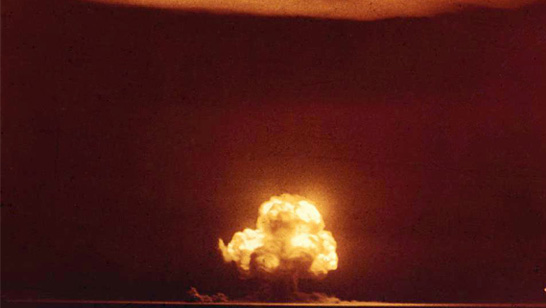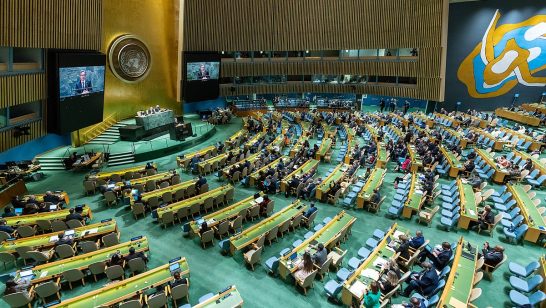The Treaty on the Non-Proliferation of Nuclear Weapons (NPT) is regarded as the cornerstone of the global nuclear non-proliferation regime and an essential foundation for the pursuit of nuclear disarmament. The NPT should also serve as a key forum to manage risks and disagreements surrounding nuclear weapons and technologies, including the threat and risks of use.
Since Russia’s full-scale invasion of Ukraine in February 2022, the concrete risks of nuclear use have increased, but the international community has yet to find appropriate measures to decrease or evade them. Nuclear threats, implicit or explicit, are not new; short of a legal norm, the practice and tradition of nuclear non-use known as the ‘nuclear taboo’ has been put under stress in the past decade by the normalisation of ‘loose talk’ surrounding nuclear weapons and their possible use.
A new policy brief from our “Protecting the Non-Proliferation Treaty” project, supported by the Norwegian Ministry of Foreign Affairs, examines:
- What specifically constitutes a ‘nuclear threat’ within the NPT framework;
- Whether it’s possible to distinguish between ‘defensive’ and ‘offensive’ nuclear threats, politically, legally, and morally;
- Whether the understanding of nuclear threats has changed with Russia’s full-scale invasion of Ukraine in 2022;
- How NPT member states should react to any nuclear threats;
- What would be achievable goals to set for the next review cycle.
It argues that states should take efforts to prevent the erosion of the nuclear taboo, reinforce the principle of the non-use of force, and declare the inadmissibility of all nuclear weapons use and threat of use. To that end, in the current NPT Review Cycle, NPT States Parties could implement the following recommendations to strengthen the NPT and the nuclear taboo:
States should take efforts to prevent the erosion of the nuclear taboo, reinforce the principle of the non-use of force, and declare the inadmissibility of all nuclear weapons use and threat of use.
Recommendations for the 2026 Review Cycle
- Reaffirm the statement from the 200 RevCon Final Document and the 2010 Action Plan that the “total elimination of nuclear weapons” constitutes the “only absolute guarantee against the use or threat of use of nuclear weapons.”
- Establish a common understanding and definition of a ‘nuclear threat’ amongst all NPT member states. This could build on the ICJ’s existing definition and offer a consensus on whether it is possible to objectively distinguish between varieties of ‘nuclear threats’, including whether a legitimate and objective distinction between ‘offensive’ and ‘defensive’ nuclear threats exists, and if so, how it could be defined on a consensus basis amongst all parties. The UN General Assembly could also explore the possibility of submitting a renewed inquiry to the ICJ for an Advisory Opinion on the question of the legality of nuclear threats, given developments in the years since the 1996 Advisory Opinion.
- Reaffirm that strengthening negative security assurances and NWFZs are necessary interim steps towards a world without nuclear weapons.
- Reiterate the importance of the nuclear taboo and the principle of non-use of force. This could take place through the NPT and the UN General Assembly, the added value of the latter being that non-NPT weapons states could join.
- Reiterate the G20 statement that the “use or threat of use of nuclear weapons is inadmissible” in the NPT RevCon Final Documents. In addition, States could also follow up the 2014 UNGA Resolution on a ‘Convention on the Prohibition of the Use of Nuclear Weapons’, with a new resolution on the inadmissibility of threats of nuclear weapons use. This would strengthen the nuclear taboo.
- Secure commitments by the P5 to increase transparency about nuclear capabilities; pursue dialogue and cooperation to enhance stability; bolster existing formats for discussion and risk reduction measures; decrease nuclear threats; and reiterate their commitment to deliver on commitments under Article VI.
Read the paper here.
Read the recommendations here.
This paper is part of the ELN’s project Protecting the Non-Proliferation Treaty. The project seeks to preserve the multilateral nuclear non-proliferation regime and prevent further erosion of the nuclear taboo and the Nuclear Non-proliferation Treaty (NPT). Bringing together an intergenerational, pan-regional Network of experts, it works to identify pathways to success in the eleventh review cycle, taking a holistic approach to the NPT and its three pillars. We are grateful for comments and feedback from several NPT member state officials on drafts of this paper.
The opinions articulated above represent the views of the author(s) and do not necessarily reflect the position of the European Leadership Network or any of its members. The ELN’s aim is to encourage debates that will help develop Europe’s capacity to address the pressing foreign, defence, and security policy challenges of our time.
Image: Model of where the atomic bomb exploded on Hiroshima, Hiroshima Peace Memorial Museum, Wikimedia commons, Derek Springer



